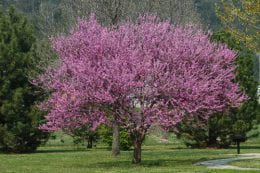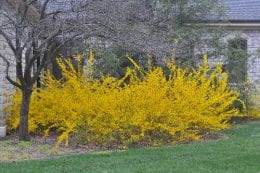By Jack Fry and Ward Upham
Efficacy of some preemergence herbicides is strongly dependent upon the timing of application relative to crabgrass emergence. For example, application of a preemergence herbicide that has a relatively short residual, such as pendimethalin, closer to crabgrass emergence, will extend the period of time which the herbicide is effective. Herbicides with longer residuals, such as prodiamine (Barricade), are often applied well before crabgrass emergence, and can even be effective if applied late in the previous autumn.
In our climate, calendar dates don’t always adequately identify crabgrass emergence or herbicide application. Biological indicators, such as flowering ornamentals, may be useful for predicting crabgrass emergence and preemergence herbicide application.
From 1995 to 1997, K-State researchers worked with those at the Univ. of Nebraska to identify ornamentals at each location which best represented crabgrass emergence and preemergence herbicide application time. Ornamentals evaluated were bridal wreath spirea, callery pear, daffodil, flowering quince, forsythia, iris, lilac, redbud, saucer magnolia, tulip, and vanhoutte spirea. Obviously, there may be ornamental cultivar differences in blooms, so this was an average of those observed. In addition, crabgrass can vary in rate of emergence, but getting an herbicide out before the first plants emerge is preferable. For this article, we’ll focus on results in Kansas.
Crabgrass emergence in bare soil and thin turf was evaluated at the Rocky Ford Research Center in Manhattan. Over three years, the earliest date of crabgrass emergence in bare soil was April 15 1995, whereas the latest date was May 9, 1996. In the thin turf (10% bare soil evident while standing), the earliest date of emergence was May 5, 1997 and the latest date was May 22, 1995.
Withering of blooms was a better indicator of crabgrass emergence, particularly in thin turf. In this case, we looked at bloom wither and then compared it to a date 2 weeks prior to emergence. This 2-week window would allow time for the herbicide to be applied. In Kansas, withering of most ornamentals was not useful for estimating emergence of crabgrass in bare soil, as emergence often occurred before blooms had withered. However, a date 2 weeks prior to crabgrass emergence in bare soil could be estimated by adding 6 to 12 days to the date of daffodil wither.


Bloom wither of flower ornamentals was used as a date to determine time of application of short-residual preemergence herbicides (a date 2 weeks prior to crabgrass emergence)
Flower wither of all ornamentals could be used indicators of emergence (and herbicide application date) in thin turf in Kansas (see Table 1 below). For example, by adding 28 to 33 days to the date of forsythia bloom wither, you will estimate a date 2 weeks prior to crabgrass emergence in thin turf, which would allow time for preemergence herbicide application. This timeline is quite different from the often used theory that herbicides must be put down at the time forsythia blooms. Ultimately, biological indicators, along with soil temperatures, will be better indicators of for crabgrass emergence and application of short-residual preemergence herbicides than calendar dates.
Table 1. Ornamentals and the number of days to be added to flower wither to estimate the date 2 weeks prior to crabgrass emergence in thin turf. Data were based upon observation of ornamental blooms and crabgrass emergence for a 3-year period.
| Ornamental | Number of days to add to bloom wither to estimate the date 2 weeks before crabgrass emergence (range allows for standard error) |
| Bridal wreath spirea | 4 to 13 |
| Callery pear | 32 to 41 |
| Flowering quince | 36 to 42 |
| Forsythia | 28 to 33 |
| Iris | 8 to 15 |
| Lilac | 17 to 22 |
| Redbud | 25 to 32 |
| Saucer magnolia | 28 to 32 |
| Tulip | 21 to 29 |
Note – This article is based upon:
Fry, J., S. Rodie, R. Gaussoin, S. Wiest, W. Upham, and A. Zuk. 2001. Using flowering ornamentals to guide preemergence herbicide application in the Midwest U.S. International Turfgrass Society Research Journal. p. 1009-1012.